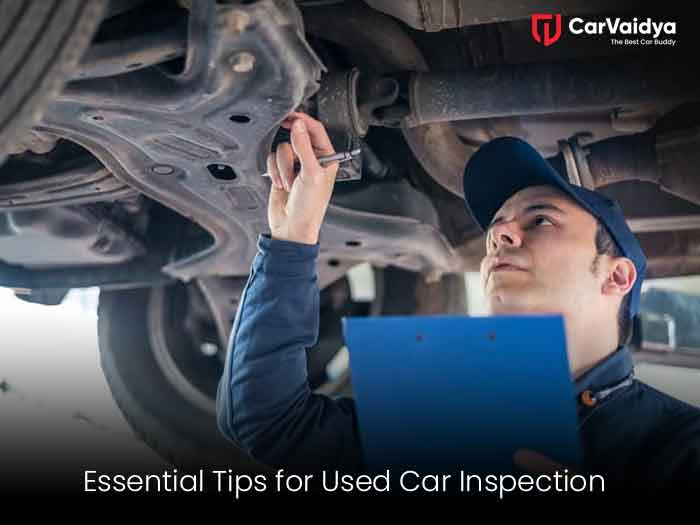Important points for car inspection before buying Used Car

 By CarVaidya
By CarVaidya- 17 Feb 2024
Important points for car inspection before buying Used Car
Many people who cannot afford to buy new cars often opt to purchase used cars in India. For these individuals, it's crucial to thoroughly inspect the car before making a purchase. In this regard, we have prepared a comprehensive checklist outlining all the important aspects to consider before using your car. In this blog, we will discuss How to inspect a used car and provide detailed information on what specific aspects to examine during the car inspection process. We'll cover external and internal components, engine conditions, and provide a checklist for inspection.
Used Car Inspection Checklist
The checklist for inspecting a used car is prepared in advance so that we can assess our car from every angle to see how it is. During the car inspection, we do not overlook important factors, which is why a checklist is created. It pays attention to your needs. When you think about thoroughly inspecting your used car, this checklist caters to every aspect meticulously. It is a systematic tool that leaves no stone unturned. It covers every aspect from the exterior of the car to the engine oil and even listening to the sound of the car during the test drive, enabling us to understand if the car is worth purchasing or not. The used car market in India was never as prominent before, and this checklist tells everything about how your car is performing, its history, and more.
The Importance of Thoroughly Inspecting a Used Car in India
It is essential to thoroughly inspect a used car to ensure that it meets your expectations, especially regarding its performance on the diverse roads of India. Before purchasing any used car, it is crucial to examine it carefully to ascertain that it runs smoothly and efficiently.
Revealing Hidden Problems
A thorough car inspection helps uncover any underlying mechanical or structural issues that may not be immediately visible. This can include issues with the engine, transmission, suspension, brakes, or chassis. Identifying these problems beforehand can save you from unexpected and costly repairs down the line.
Ensuring Safety
Inspecting a used car allows you to verify the functionality of essential safety features such as brakes, tires, airbags, lights, and seat belts. Ensuring that these safety components are in good working condition minimizes the risk of accidents and enhances the overall safety of the vehicle for you and your passengers.
Determining Value
By examining the condition of the used car, you can better assess its true value. Any defects or maintenance needs discovered during the car inspection can be used as leverage during price negotiations. Additionally, knowing the car's condition helps you avoid overpaying for a vehicle that may require significant car repairs or maintenance in the near future.
Adaptation to Road Conditions
India's roads vary widely in terms of quality, from well-maintained highways to rough rural roads. Inspecting the car allows you to assess its suitability for navigating these diverse road conditions. A car that is well-suited to handle potholes, uneven surfaces, and other challenges commonly encountered on Indian roads will provide a more reliable and comfortable driving experience.
Peace of Mind
Lastly, conducting a thorough inspection before purchasing a used car provides peace of mind. Knowing that you have thoroughly examined the vehicle and are aware of its condition instills confidence in your decision-making process. It reduces the likelihood of buyer's remorse and ensures that you are making a well-informed investment.
Exterior Inspection Checklist
- Body Panels: Inspect each body panel for signs of damage, dents, or scratches. Check for uniformity in panel gaps, indicating potential repair or collision damage.
- Paint Quality: Examine the paint for any chips, cracks, fading, or inconsistencies in color. Look for areas of rust or corrosion, especially around the edges of panels and underneath the car.
- Lights and Lenses: Test all exterior lights, including headlights, taillights, brake lights, turn signals, and fog lights. Inspect the lenses for cracks, moisture, or discoloration.
- Tires and Wheels: Check the tread depth and condition of the tires for uneven wear, bulges, or punctures. Inspect the wheels for any damage, such as bends or cracks, and ensure that the lug nuts are tightened properly.
- Safety Features: Verify the functionality of essential safety features, including seat belts, airbags, and child safety locks. Ensure that all safety systems are in good working condition to provide optimal protection for occupants.
Engine Inspection Checklist
- Fluid Levels: Check the levels and condition of engine oil, transmission fluid, coolant, brake fluid, and power steering fluid. Ensure that they are at the appropriate levels and free from contaminants or discoloration.
- Leaks: Inspect the engine and surrounding components for any signs of oil, coolant, or other fluid leaks. Look for wet spots or stains underneath the car and around gaskets, seals, and hoses.
- Belts and Hoses: Check the condition of drive belts and hoses for any signs of wear, cracks, or fraying. Pay particular attention to the timing belt (if applicable) and ensure that it is not overdue for replacement.
- Battery: Inspect the battery terminals and cables for corrosion or damage. Test the battery voltage and ensure that it is holding a charge within the manufacturer's specifications.
- Engine Bay: Examine the engine bay for any signs of rust, corrosion, or damage. Look for loose or missing bolts, brackets, or covers. Ensure that all components are securely fastened and properly aligned.
- Exhaust System: Check the exhaust system for any signs of damage, rust, or leaks. Listen for any unusual noises, such as rattling or hissing, that may indicate exhaust leaks or muffler issues.
- Engine Operation: Start the engine and listen for any unusual noises, such as knocking, ticking, or squealing. Pay attention to how the engine idles and accelerates, and check for any smoke or unusual odors from the exhaust.
Test Drive Checklist
- Starting the Engine: Ensure the engine starts smoothly without any hesitation or unusual noises. Pay attention to how quickly it starts and any warning lights on the dashboard.
- Braking: Test the brakes at different speeds and pressures. Ensure that the car stops smoothly and without pulling to one side. Listen for any grinding or squealing noises that may indicate brake issues.
- Steering and Handling: Evaluate the car's steering response and handling characteristics. Check for any excessive play in the steering wheel and assess how the car corners and maneuvers.
- Suspension: Drive over bumps, potholes, and uneven surfaces to assess the suspension's performance. Listen for any clunking or rattling noises and feel for any excessive bouncing or instability.
- Transmission: Test the transmission through various gears, including acceleration, deceleration, and cruising. Pay attention to how smoothly it shifts and whether there are any delays or jerks.
And Apart from above steps, ensure your peace of mind when purchasing a used car by booking CarVaidya's Used Car Inspection Service. Their thorough analysis guarantees authenticity and detail, helping you make informed decisions.
You can read some other articles
Here Are 5 Mistakes to Avoid While Driving a Car with a Manual Transmission
The Part Essential for Driving When It Malfunctions Requires Specific Modification
Top 15 Car Care Tips For Rainy Season




0 Comments